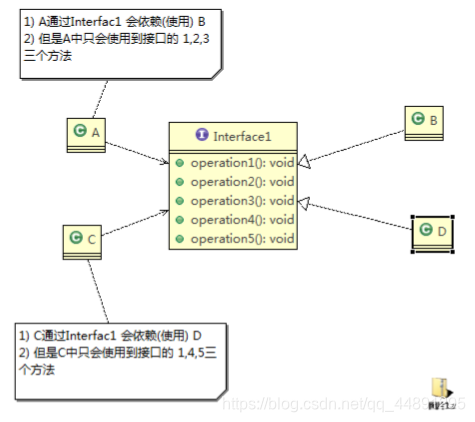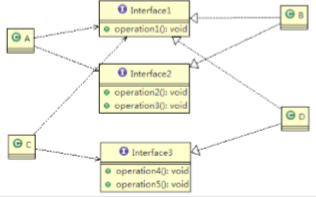JAVA设计模式七大原则—— 单一职责原则
JAVA设计模式七大原则—— 接口隔离原则
JAVA设计模式七大原则—— 依赖倒转原则
JAVA设计模式七大原则—— 里氏替换原则
JAVA设计模式七大原则—— 开闭原则
JAVA设计模式七大原则—— 迪米特法则
JAVA设计模式七大原则—— 合成复用原则
基本介绍
- 客户端不应该依赖它不需要的接 口,即一个类对另一个类的依赖 应该建立在最小的接口上
我们先看一张图片

传统方法是这么写的
Segregation1.class
public class Segregation1 {
public static void main(String[] args) {
// 使用一把
A a = new A();
a.depend1(new B()); // A类通过接口去依赖B类
a.depend2(new B());
a.depend3(new B());
C c = new C();
c.depend1(new D()); // C类通过接口去依赖(使用)D类
c.depend4(new D());
c.depend5(new D());
}
}
//接口
interface Interface1 {
void operation1();
void operation2();
void operation3();
void operation4();
void operation5();
}
class B implements Interface1 {
public void operation1() {
System.out.println("B 实现了 operation1");
}
public void operation2() {
System.out.println("B 实现了 operation2");
}
public void operation3() {
System.out.println("B 实现了 operation3");
}
public void operation4() {
System.out.println("B 实现了 operation4");
}
public void operation5() {
System.out.println("B 实现了 operation5");
}
}
class D implements Interface1 {
public void operation1() {
System.out.println("D 实现了 operation1");
}
public void operation2() {
System.out.println("D 实现了 operation2");
}
public void operation3() {
System.out.println("D 实现了 operation3");
}
public void operation4() {
System.out.println("D 实现了 operation4");
}
public void operation5() {
System.out.println("D 实现了 operation5");
}
}
class A { //A 类通过接口Interface1 依赖(使用) B类,但是只会用到1,2,3方法
public void depend1(Interface1 i) {
i.operation1();
}
public void depend2(Interface1 i) {
i.operation2();
}
public void depend3(Interface1 i) {
i.operation3();
}
}
class C { //C 类通过接口Interface1 依赖(使用) D类,但是只会用到1,4,5方法
public void depend1(Interface1 i) {
i.operation1();
}
public void depend4(Interface1 i) {
i.operation4();
}
public void depend5(Interface1 i) {
i.operation5();
}
}
客户端不应该依赖它不需要的接 口(A类中只会用到1,2,3方法,C类中只会用到1,4,5方法),即一个类对另一个类的依赖 应该建立在最小的接口上
解决方案:将接口Interface1拆分为独立的几个接口, 类A和类C分别与他们需要的接口建立依赖 关系。也就是采用接口隔离原则

改进后
SegregationImprove.class
public class SegregationImprove{
public static void main(String[] args) {
// 使用一把
A a = new A();
a.depend1(new B()); // A类通过接口去依赖B类
a.depend2(new B());
a.depend3(new B());
C c = new C();
c.depend1(new D()); // C类通过接口去依赖(使用)D类
c.depend4(new D());
c.depend5(new D());
}
}
// 接口1
interface Interface1 {
void operation1();
}
// 接口2
interface Interface2 {
void operation2();
void operation3();
}
// 接口3
interface Interface3 {
void operation4();
void operation5();
}
class B implements Interface1, Interface2 {
public void operation1() {
System.out.println("B 实现了 operation1");
}
public void operation2() {
System.out.println("B 实现了 operation2");
}
public void operation3() {
System.out.println("B 实现了 operation3");
}
}
class D implements Interface1, Interface3 {
public void operation1() {
System.out.println("D 实现了 operation1");
}
public void operation4() {
System.out.println("D 实现了 operation4");
}
public void operation5() {
System.out.println("D 实现了 operation5");
}
}
class A { // A 类通过接口Interface1,Interface2 依赖(使用) B类,但是只会用到1,2,3方法
public void depend1(Interface1 i) {
i.operation1();
}
public void depend2(Interface2 i) {
i.operation2();
}
public void depend3(Interface2 i) {
i.operation3();
}
}
class C { // C 类通过接口Interface1,Interface3 依赖(使用) D类,但是只会用到1,4,5方法
public void depend1(Interface1 i) {
i.operation1();
}
public void depend4(Interface3 i) {
i.operation4();
}
public void depend5(Interface3 i) {
i.operation5();
}
}
上述方案采用了接口隔离原则
